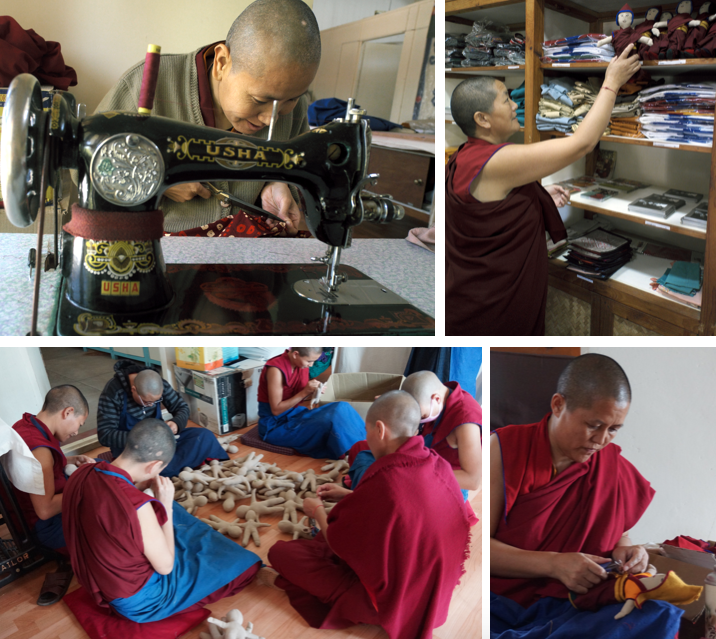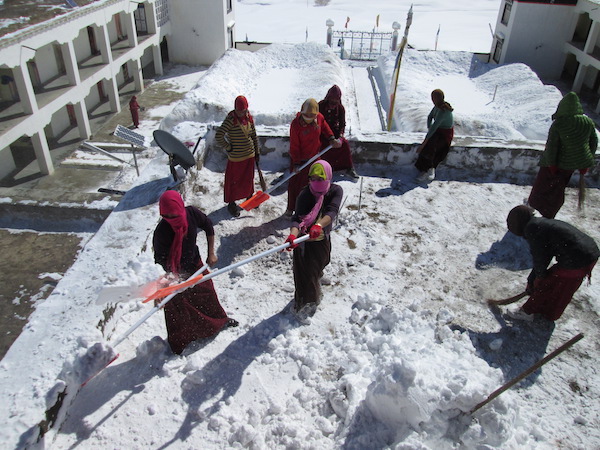Monastic debate is of critical importance in traditional Tibetan Buddhist learning. Through debate, nuns test and consolidate their classroom learning.
The following video is a great primer on Tibetan Buddhist debate by nuns. It’s taken from a longer video made by the nuns at Dolma Ling Nunnery in northern India and it answers many of the frequently asked questions about Tibetan Buddhist debate, such as the meaning of the hand movements.
Nuns Learning Tibetan Buddhist Debate
In addition to their daily debate practice, each year in India, hundreds of Tibetan Buddhist nuns from nunneries in India and Nepal gather for a special, month-long inter-nunnery debate called the Jang Gonchoe. This annual inter-nunnery debate takes place each autumn and is a critical part of the nuns’ education, allowing them to really “up their game” so to speak.

This photo shows the nuns during a night debate at Dolma Ling Nunnery and Institute. Thanks to generous donors, the new roof of the debate courtyard was completed in 2013. The special courtyard allows the nuns to debate year-round and in all weather, including during the heaviest storms and monsoon rains.
Prior to 1995, there was no Jang Gonchoe for nuns and this learning opportunity was only open to monks. The Tibetan Nuns Project, with the wonderful support of His Holiness the Dalai Lama, played a critical role in opening up this learning opportunity to women. Establishing a comparable debate session for nuns has been an integral part of the nuns reaching their current level of excellence in their studies.
The inter-nunnery debate helps bring the nuns closer to equality with the monks in terms of learning opportunities and advancement along the spiritual path. For many, the Jang Gonchoe is an essential component of working towards higher academic degrees, such as the Geshema degree, equivalent to a doctorate in Tibetan Buddhism.
“It all happened because of the kindness, generosity, and genuine concern shown by all the wonderful donors who supported us for so many years. Much as we had the blessings from His Holiness the Dalai Lama and the vision, determination, and courage to pursue this matter to the full, without their generosity we would not have been able to have the Jang Gonchoe every year, which was and is the moving force behind every step of progress in education the nuns have made,” said Rinchen Khando Choegyal, Founder and Director of the Tibetan Nuns Project.
The Jang Gonchoe Annual Inter-Nunnery Debate
The inter-nunnery debate has been supported since 1997 by the Tibetan Nuns Project. We hope that, with gifts to our Jang Gonchoe Endowment Fund and to help the annual debate, the inter-nunnery debate will be able to continue for many years to come. Donations help to cover costs such as transportation, food, and accommodation for the nuns who wish to attend.

Nuns debate in front of His Holiness the Dalai Lama on the last day of the Jang Gonchoe in 2014. Photo courtesy of Tenzin Choejor, OHHDL
His Holiness the Dalai Lama has often spoken of the need to examine the teachings of the Buddha closely and with an inquisitive mind. “This is the 21st century and we need to understand the Buddha’s teachings in the light of reason. When we teach, we need to do so on the basis of reason,” His Holiness the Dalai Lama told the nuns at the end of the 2014 Jang Gonchoe.
His Holiness added, “Nowadays, the Nalanda tradition of approaching the Buddha’s teachings with logic and reason is only found amongst Tibetans. It’s something precious we can be proud of and should strive to preserve.”

A teacher with the nuns during the 2015 Jang Gonchoe debate event in Dharamsala. 2015 marked the 20th anniversary of the inter-nunnery debate which draws hundreds of nuns each year.
If you would like to support the Jang Gonchoe, we would be most grateful. Gifts to our Jang Gonchoe Endowment Fund help to both preserve the Tibetan culture and open up this centuries-old tradition to the nuns, enabling and empowering them to become great teachers in their own right.



